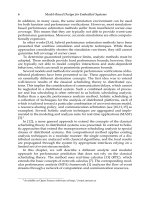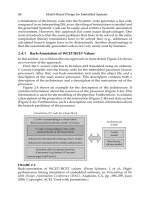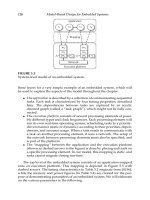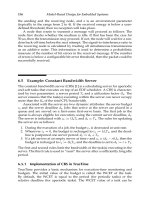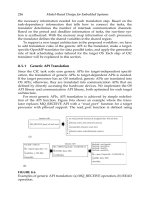Model-Based Design for Embedded Systems- P71 ppsx
Bạn đang xem bản rút gọn của tài liệu. Xem và tải ngay bản đầy đủ của tài liệu tại đây (437.96 KB, 10 trang )
Nicolescu/Model-Based Design for Embedded Systems 67842_C020 Finals Page 686 2009-10-2
686 Model-Based Design for Embedded Systems
rst
Clock&Reset
1
0
MM M
X
X01234
01
01
03
03
03
03
03
03
56789ABCDEF
977
250 μm
XX
XX
XX
XX
Now
8000000 pa
XXX
0
0
0
0
00
00
00
00
0
0
0
00
00
00
00
1
clk
Configuration control
D
valid
iond
en
clk_gel
pattern
sel
Input from Fiber/circuits
Output from Fiber/circuits
input_0
input_1
input_2
input_3
output_0
output_1
output_2
output_3
Clock & Reset
FIGURE 20.28
FIG test system block diagram: Areas in the digital domain are executed in
ModelSim while areas in the analog and optical domains are executed in
Chatoyant.
CLk4X
CLk4X
Data1
PIN PD
array
Receiver
circuitry
8:1 DDR
deserializer
1:8 DDR
Serializer
1:8 DDR
Serializer
8:1 DDR
deserializer
Dout
(7:0)
Dout
(15:8)
Clk1X_Out
RXTX
Driver
circuitry
4 free-space
optical links
Electrical output
Electrical input
Din
(7:0)
Din
(15:8)
Clk1X_IN
Clk4X_IN
VCSEL
array
Data2
FIGURE 20.29
SPOT system block diagram showing the digital data entering in parallel
to the UTSI transceiver chip, serialized transmitted over free-space optics,
deserialized with clock-recovery, back into parallel data. (Courtesy of [52].)
propagated light back into analog signals at which point the analog circuits
amplify and feed the de-serializing logic in the digital domain. Figure 20.29
shows the system block diagram.
Nicolescu/Model-Based Design for Embedded Systems 67842_C020 Finals Page 687 2009-10-2
CAD Tools for Multi-Domain Systems on Chips 687
SPOT tests the ability of the co-simulation environment to work with
a global clock signal. This clock signal, generated by the digital domain,
is transmitted with the data, and thus crosses the co-simulation interface.
This means that there are a large number of periodic events occurring. This
illustrates the simulation behavior of a synchronous system versus an asyn-
chronous system in the co-simulation environment.
Given these two systems, we next show the results of runtimes and event
traffic for different time resolutions of the SYNC_PULSE parameter. A total
of four resolutions were tested, 1 ps, 10 ps, 100 ps, and 1 ns. These values
were chosen since the systems run at relatively high frequencies, in the range
of nanoseconds for both data bit rate and clock speed. All simulations were
performed on a Dual 1.70 MHz Intel Xeon Processor Dell Precision with 3
GBs of RAM running Red Hat Linux 7.3, kernel version 2.4.18-3SMP.
20.3.2.3 FIG Runtimes
The following set of charts show the runtime and event traffic seen in each
of the resolution steps. Figure 20.30 shows the runtime, in seconds versus
the four different time resolutions. Figure 20.31 shows the event counts seen
from the Chatoyant and ModelSim perspectives.
As seen in Figure 20.30, the runtimes decreased as the resolution became
coarser. One thing to note is the logarithmic-like decay. This is most likely
because of the total simulation time of the experiment rather than the time
resolution. Since all simulations were performed for a simulation time of
154.22 141.01163.75214.43
100 ps 1 ns10 ps1 ps
0.00
50.00
100.00
150.00
200.00
250.00
Series1
Seconds
Runtime vs. sync resolution
FIGURE 20.30
Runtime versus Sync resolution for FIG.
Nicolescu/Model-Based Design for Embedded Systems 67842_C020 Finals Page 688 2009-10-2
688 Model-Based Design for Embedded Systems
Chatoyant RX
0
1000
2000
3000
4000
5000
Number of events vs. resolution
Event count
Chatoyant TX
ModelSim RX
ModelSim TX
4
1 ps Sync
1,077
4,307
12
4
10 ps Sync
37
147
12
4
100 ps Sync
8
32
12
4
1 ns Sync
4
16
12
FIGURE 20.31
Number of events per simulation for FIG.
1.4 us, the closer the granularity of the resolution is to the magnitude of the
end time, the smaller the difference will be in runtimes. This is explained
by the notion that less event processing is performed since more events are
ignored between synchronization points. Therefore, event processing over-
head is reduced.
Also, the amount of event traffic decreases by two orders of magnitude
between 1 ps and 1 ns resolutions. This is also related to the fact that more
events are processed at higher resolutions.
20.3.2.4 SPOT Runtimes
The SPOT system yields a different perspective on the co-simulation system.
Figure 20.32 shows the runtime results versus resolution and Figure 20.33
shows the event traffic at each resolution.
As seen in Figure 20.32, the runtimes do decrease, in general, with respect
to an increasing granularity. The exception to this is the 10 ps resolution,
which shows a slight increase in runtime compared to the 1 ps resolution.
This may be because of the processing of more event changes given the peri-
odicity of the clock signal in the system. Regardless of this outlier, there is
still a general trend for decreasing runtimes as well as decreased event traf-
fic with lower resolutions.
SPOT having a higher runtime versus FIG indicates the effect of the
clock signal on performance. Since there is a clock having a consistent event
Nicolescu/Model-Based Design for Embedded Systems 67842_C020 Finals Page 689 2009-10-2
CAD Tools for Multi-Domain Systems on Chips 689
Seconds
0.00
200.00
400.00
600.00
800.00
1000.00
1200.00
1400.00
1600.00
1800.00
2000.00
Runtime vs. sync resolution
1 ps 10 ps 100 ps 1 ns
1605.67 1722.50 843.31 842.65
FIGURE 20.32
Runtime results versus resolution granularity.
change at a fixed frequency, the number of events per synchronization cycle
increases. This is seen by the higher event counts in each SPOT simulation
versus those for FIG. This amount, spread uniformly across the entire simu-
lation in SPOT, versus FIG which has dense cluster of events separated by a
large time gap, exemplifies the overhead associated with processing events.
20.4 Summary
In summary, we have presented a co-simulation environment for mixed-
domain, mixed-signal simulation that spans the realms of HDL digital logic,
analog electrical, optical, and mechanical systems. A variety of modeling
techniques are used to develop analog component models that are evalu-
ated using continuous time models. These component behaviors commu-
nicate via specific ports that pass complex messages between components.
Those messages, and the corresponding execution of the component mod-
els, are coordinated by a DE simulation backbone. This backbone, built
on Ptolemy, also runs in coordination with a commercial HDL simulator.
Nicolescu/Model-Based Design for Embedded Systems 67842_C020 Finals Page 690 2009-10-2
690 Model-Based Design for Embedded Systems
4000
3500
3000
2500
2000
1500
1000
500
0
1 ps Sync
146
Chatoyant RX
Chatoyant TX
ModelSim RX
ModelSim TX
146 146 142
175
175
144
3499 3499 1750
179435433543
150 150 150
10 ps Sync 100 ps Sync 1 ns Sync
Number of events vs. resolution
Event count
FIGURE 20.33
Event traffic versus resolution granularity.
This system, known as Chatoyant–ModelSim Co-Simulation Environment,
provides an interface between the multi-domain analog realm handled by
Chatoyant and the digital realm, handled by ModelSim.
As seen in the co-simulation experiments, there are a few factors that
affect runtime performance. Asynchronous systems with more clustering of
events within certain windows generally have a better runtime than syn-
chronous systems that have a steady load of events. Also, as predicted, the
resolution of synchronization, defined in the context of the PDES conserva-
tive approach and implemented using Unix IPC, has an effect on runtime
performance by reducing the event processing overhead, at the cost of accu-
racy. This cost is assessed based on the system and requirements a particular
user has for the simulation.
20.4.1 Conclusions
Multi-domain modeling and multi-rate simulation tools are required to sup-
port mixed-technology system design. This chapter has shown Chatoyant’s
support for simulating and analyzing optical MEM systems with models
for optical, electrical, and mechanical models for components and signals.
By supporting a variety of component and signal modeling techniques and
multiple abstraction levels, Chatoyant has the ability to perform and ana-
lyze mixed-signal tradeoffs, which makes it valuable to multi-technology
system designers. Keeping simulations, along with analysis techniques such
Nicolescu/Model-Based Design for Embedded Systems 67842_C020 Finals Page 691 2009-10-2
CAD Tools for Multi-Domain Systems on Chips 691
as Monte Carlo for mechanical tolerancing, BER, crosstalk, and insertion loss
within the Chatoyant framework allows for quick and efficient system-level
design and analysis for the future development of next generation MDSoCs.
Acknowledgments
The work in this chapter was supported by DARPA, under Grant No. F3602-
97-2-0122 and NSF, under Grant No. ECS-9616879 and CCR 88319. The Uni-
versity of Delaware is acknowledged for providing the SPOT system data for
testing.
References
1. J. Buck, S. Ha, E. A. Lee, andD.Messerschmitt, Ptolemy: A framework for
simulating and prototyping heterogeneous systems, International Journal
on Computer Simulation, 4, 155–182, 1994.
2. K. Hines and G. Borriello, Dynamic communication models in embedded
system co-simulation, Proceedings of ACM SIGDA for the Design Automa-
tion Conference (DAC’97), Anaheim, CA, 1997.
3. C. Liem, F. Nacabal, C. Valderrama, P. Paulin, and A. Jerraya, System-on-
a-chip cosimulation and compilation, IEEE Design and Test of Computers,
14(2), 16–25, April–June 1997.
4. S. P. Levitan, T. P. Kurzweg, P. J. Marchand, M. A. Rempel, D. M.
Chiarulli, J. A. Martinez, J. M. Bridgen, C. Fan, and F. B. McCormick,
Chatoyant: A computer-aided design tool for free-space optoelectronic
systems, Applied Optics, 37(26), 6078–6092, September 1998.
5. E. A. Lee and H. Zheng, Modeling and simulation of mixed continuous
and discrete systems, Model-Based Design for Embedded Systems, Taylor &
Francis, Boca Raton, FL, 2009.
6. L. Gheorghe, G. Nicolescu, and H. Boucheneb, A generic methodology
for the design of continuous/discrete co-simulation tools, Model-Based
Design for Embedded Systems, Taylor & Francis, Boca Raton, FL, 2009.
7. S. P. Levitan, P. J. Marchand, T. P. Kurzweg, M. A. Rempel, D. M.
Chiarulli, C. Fan, and F. B. McCormick, Computer-aided design of
free-space opto-electronic systems, Proceedings of the 1997 Design Automa-
tion Conference, Anaheim, CA, June 1997, Best Paper Award, pp. 768–773.
Nicolescu/Model-Based Design for Embedded Systems 67842_C020 Finals Page 692 2009-10-2
692 Model-Based Design for Embedded Systems
8. T. P. Kurzweg, S. P. Levitan, P. J. Marchand, J. A. Martinez, K. R. Prough,
and D. M. Chiarulli, CAD for optical MEMS, Proceedings of the 36th
IEEE/ACM Design Automation Conference (DAC’99), New Orleans, LA,
June 20–25, 1999.
9. T. P. Kurzweg, S. P. Levitan, P. J. Marchand, J. A. Martinez, K. R. Prough,
and D. M. Chiarulli., Modeling and simulating optical MEMS using Cha-
toyant, Design, Test, and Microfabrication of MEMS/MOEMS, Paris, France,
March 30–April 1, 1999.
10. S. P. Levitan, J. A. Martinez, T. P. Kurzweg, A. J. Davare, M. Bails,
M. Kahrs, and D. M. Chiarulli, System simulation of mixed-signal multi-
domain microsystems with piecewise linear models, IEEE Transactions on
CAD of ICs and Systems, 22(2), 139–154, February 2003.
11. A. Jose and M. S. Martinez, Piecewise linear simulation of optoelectronic
devices with application to MEMS, Department of Electrical Engineer-
ing, University of Pittsburgh, Pittsburgh, PA, June 2000.
12. J. A. Martinez, S. P. Levitan, and D. M. Chiarulli, Nonlinear model order
reduction using remainder functions, IEEE Computer Society, Design,
Automation and Test in Europe (DATE’06) ICM, IP2 Interactive presentations,
Paper No. 791, pp. 281–282, MESSE Munich, Germany, March 6–10, 2006.
13. J. Morikuni and S. Kang, Computer-Aided Design of Optoelectronic Inte-
grated Circuits and Systems, Prentice-Hall, Inc., Upper Saddle River, NJ,
Chapter 6, 1997.
14. E. M. Buturla, P. E. Cottrell, B. M. Grossman, and K. A. Salsburg, Finite
element analysis of semiconductor devices: The FIELDAY program, IBM
Journal of Research and Development, 25, 218–231, 1981.
15. M. R. Pinto, C. S. Rafferty, and R. W. Dutton, PISCES II—Poisson and
continuity equation solver, Stanford Electronics Laboratory Technical
Report, Stanford University, Stanford, CA, September 1984.
16. P. C. H. Chan and C. T. Sah, Exact equivalent circuit model for steady-
state characterization of semiconductor devices with multiple energy-
level recombination centers, IEEE Transactions of Electronic Devices,
ED-26, 924–936, 1979.
17. R. Kielkowski, SPICE, Overcoming the Obstacles of Circuit Simulation,
Chapter 4, McGraw-Hill, Inc., New York, 1994.
18. S. Kim, N. Gopal, and L. T. Pillage, Time-domain macromodels for VLSI
interconnect analysis, IEEE Transactions on CAD of Integrated Circuits and
Systems, 13(10), 1257–1270, October 1994.
Nicolescu/Model-Based Design for Embedded Systems 67842_C020 Finals Page 693 2009-10-2
CAD Tools for Multi-Domain Systems on Chips 693
19. A. Devgan and R. A. Rohrer, Adaptively controlled explicit simulation,
IEEE Transactions on CAD of Integrated Circuits and Systems, 13, 746–762,
June 1994.
20. P. Feldmann and R. W. Freund, Efficient linear circuit analysis by Padé
approximation via the Lanczos process, IEEE Transactions on Computer-
Aided Design, 14, 639–649, May 1995.
21. A. Odabasioglu, M. Celik, and L. T. Pileggi, PRIMA: Passive reduced-
order interconnect macromodeling algorithm, IEEE Transactions on
Computer-Aided Design, 17(8), 645–654, 1998.
22. L. T. Pillage and R. A. Rohrer, Asymptotic waveform evaluation for tim-
ing analysis, IEEE Transactions on Computer-Aided Design, 9(4), 352–366,
April 1990.
23. L. W. Nagel, SPICE2, a computer program to simulate semiconductor
circuits, Technical Report Memo UCB/ERL M520, University of Califor-
nia, Berkeley, CA, May 1975.
24. A. Salz and M. Horowitz, IRSIM: An incremental MOS switch-level sim-
ulator, Proceedings of the 26th Design Automation Conference, Las Vegas,
NV, pp. 173–178, 1989.
25. R. Kao and M. Horowitz, Timing analysis for piecewise linear Rsim, IEEE
Transactions on Computer-Aided Design, 13(12), 1498–1512, 1994.
26. J. Vlach and K. Singhai, Computer Methods for Circuit Analysis and Design
(2nd edn.), John Wiley & Sons, Inc., New York, 1993.
27. J. Clark, N. Zhou, S. Brown, and K. S. J. Pister, Nodal analysis for MEMS
simulation and design, Proceedings of Modeling and Simulation of Microsys-
tems Workshop, Santa Clara, CA, April 6–8, 1998.
28. J. E. Vandemeer, Nodal design of actuators and sensors (NODAS), MS
Thesis, Department of Electrical and Computer Engineering, Carnegie
Mellon University, Pittsburgh, PA, 1997.
29. J. E. Vandemeer, M. S. Kranz, and G. K. Fedder, Hierarchical represen-
tation and simulation of micromachined inertial sensors, Proceedings of
Modeling and Simulation of Microsystems Workshop, Santa Clara, CA, April
6–8, 1998.
30. W. J. Duncan, Reciprocation of triply partitioned matricies, Journal Royal
Aeronautical Society, 60, 131–132, 1956.
31. J. S. Przemieniecki, Theory of Matrix Structural Analysis, McGraw-Hill,
New York, 1968.
Nicolescu/Model-Based Design for Embedded Systems 67842_C020 Finals Page 694 2009-10-2
694 Model-Based Design for Embedded Systems
32. B. E. A. Saleh and M. C. Teich, Fundamentals of Photonics, Wiley-
Interscience, New York, 1991.
33. S. J. Walker and D. J. Nagel, Optics and MEMS, Navel Research Lab,
NRL/MR/6336-99-7975, May 15, 1999.
34. M. Born and E. Wolf, Principles of Optics, Pergamon Press, London, 1959.
35. J. W. Goodman, Introduction to Fourier Optics (2nd edn.), McGraw-Hill
Companies, Inc., New York, 1996.
36. E. Hecht, Optics (2nd edn.), Addison-Wesley Publishing Company,
Reading, MA, 1987.
37. M. W. Kowarz, Diffraction effects in the near field, PhD thesis, University
of Rochester, Rochester, NY, 1995.
38. T. Tommasi and B. Bianco, Frequency analysis of light diffraction
between rotated planes, Optics Letters, 17(8), 556–558, April 1992.
39. N. Delen and B. Hooker, Free-space beam propagation between arbitrar-
ily oriented planes based on full diffraction theory: A fast Fourier trans-
form approach, JOSA, 15(4), 857–867, April 1998.
40. W. L. Briggs and V. E. Henson, The DFT: An Owner’s Manual for the
Discrete Fourier Transform, SIAM, Philadelphia, PA, 1995.
41. M. C. Wu, Micromachining for optical and optoelectronic systems,
Proceedings of the IEEE, 85(11), 1833–1856, November 1997.
42. W. Piyawattanametha, L. Fan, S. S. Lee, J. G. D. Su, and M. C. Wu,
MEMS technology for optical crosslink for micro/nano satellites, Inter-
national Conference of Integrated Nano/Microtechnology for Space Applications
(NANOSPACE98), NASA/Johnson Space Center, Houston, TX, Novem-
ber 1–6, 1998.
43. T. Akiyama, D. Collard, and H. Fujita, Scratch drive actuator with
mechanical links for self-assembly of three-dimensional MEMS, Journal
of Microelectromechanical Systems, 6(1), 10–17, March 1997.
44. D. M. Bloom, The grating light valve: Revolutionizing display technol-
ogy, Proceedings of SPIE, 3013, Photonics West, Projection Displays III,
165–171, 1997.
45. O. Solgaard, Integrated semiconductor light modulators for fiber-optic
and display applications, PhD Thesis, Stanford University, Stanford, CA,
1992.
46. Vdovin, G., LightPipes Manual,
Nicolescu/Model-Based Design for Embedded Systems 67842_C020 Finals Page 695 2009-10-2
CAD Tools for Multi-Domain Systems on Chips 695
47. L. Kriaa, W. Youssef, G. Nicolescu, S. Martinez, A. A. Jerraya, B. Courtois,
S. Levitan, J. Martinez, and T. Kurzweg, System C-based cosimulation
for global validation of MOEMS, Design Test Integration and Packaging
of MEMS/MOEMS (DTIP 2002), pp. 64–70, SPIE Proceedings Vol. 4755,
Cannes-Mandelieu, France, May 6–8, 2002.
48. ModelSim SE Foreign Language Interface, Version 5.7g., 2003.
49. P. Banerjee, Parallel Algorithms for VLSI Computer-Aided Design, Prentice
Hall, Englewood Cliffs, NJ, 1994.
50. H. Hübert, A Survey of HW/SW Cosimulation Techniques and Tools.
Thesis Work, Royal Institute of Technology, Stockholm, Sweden, 1998.
51. Donald M. Chiarulli et al., Optics in Computing, OSA Technical Digest,
Optical Society of America, Washington DC, 2001, pp. 125–127.
52. P. Gui, F. Kiamilev et al. Source synchronous double data rate (DDR)
parallel optical interconnects, Proceeding of InterPACK’03, Maui, Hawaii,
July 6–11, 2003.

